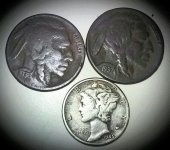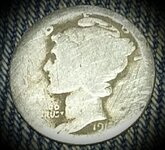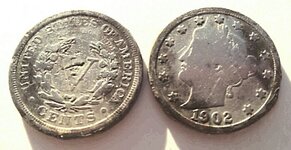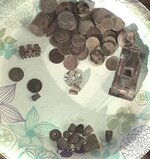digger27
Bronze Member
- May 18, 2011
- 1,506
- 3,225
These are using the F70/Patriot, you can control the thresh in disc on these.
I have done some experimenting in high thresh and in my dirt it may be a bit more advantageous.
High thresh...something to this? Really long one.
Don't know how they would work on an F75 but I assume close to the same despite that fixed thresh level in disc.
Not sure why but doing it this way keeps my non-DST rig unusually quiet, I am able to bust up the gain to 95-99 and the thresh to +5 to +9 using that Sharpshooter coil which is a little more quiet anyway than my Fisher coils but this high disc, notched in lower area stuff seems to let me turn the thresh and gain a little higher even using the big DD coil and keep my rig unusually quiet with pretty stable signals as long as I don't notch in more than two lower sections.
I believe I am still hearing tones on everything despite that high disc while having all these areas notched in.
Those settings, disc at 65, notch in EVERY other section, DP tones but all other tone selections also work well.
DE speed.
Using DP tones you hear everything but using a fast sweep and decent overlapping all repeatable tones really seem to stand out...especially the high conductive ones.
Usually I go really slow, in the areas I am trying this lately, some woods with mostly better black dirt, this very fast sweep speed seems to give me better less jumpy signals just like most have experienced that hunt in better more normal dirt than I have.
Iron is a very low growl in the background in DP I can ignore effortlessly and any high falsing from iron is easily identifiable because it doesn't repeat much and from more than one direction definitely.
I can hunt efficiently and quickly covering large areas without looking at the screen listening for those more solid repeatable signals and they pick up all metal from big to small both shallow and deep.
Using these settings in some woods recently I have picked up two mercs, two V nickels, clad, and a bunch of bullets and casings.
I used both DP and multi tones, 4H, as I said those high tones really stand out in either mode but I like DP a bit better.
There are other reasons I have been switching to DP tones more and more off my usual monotone selection, also.
Tried something new with DP...it worked!
These woods have lots of iron, tons of cans from new to old including a bunch of rusting parts on some really old ones, bottle caps galore, beaver tail tabs up the kazoo, nails and a bunch of other junk.
That faster sweep speed in this site with some decent black dirt is working well, yesterday I found several small bullets despite the iron that us still in this site including some very tiny objects despite moving and swinging that coil fast including some small copper jacketed ones and even a tiny 22 bullet casing at several inches deep.
They all sounded off super clear like they were large targets sitting in the surface.
Also a shallow modern quarter that was standing up vertically on edge.
A few days ago I found a 1901 and 1902 V nickels stuck together that were INSIDE a very old steel rusting bottle cap.
The numbers jumped a bit too much but the tone was so solid sounding I had to dig it and I was shocked when I realized what I found.
These settings get deep, stay quiet and more stable at much higher gain and thresh settings than using low disc and I think might be finding me more.
Most targets seem to be identifiable easily, bottle caps and tabs jump more than better targets like coins.
For awhile I ventured away from those woods into a more open play area with about 90-100 years of normal park trash and kept these settings including DP.
A million really fast signals hit me from iron to high, I continued to use that much faster sweep here too, and surprisingly I was still able to ID most targets fairly accurately and pick out the better coin signals and other non ferrous targets.
I dug some screw on bottle caps and several beaver tail tabs but I guessed what these were on every one before I dug them.
Don't know why these settings work this way on this thing keeping it so quiet, deep, sensitive and fast...but you can't argue with success.
The pics below are what I have found using these settings...mostly.
The nice merc and the two buffs were in a coin spill using 4H tones, the worn 1917 merc, .my oldest, and the two V nickels I was using DP.
As I mentioned the V's were stuck together INSIDE and old rusted bottle cap...a jumpy signal I might have chosen to pass on but the tone was so unusually good, sharp and solid sounding in DP I had to dig it.
The other pic is mostly what I found using these settings in those woods and a few other areas.
There are few coins in there from other hunts using different settings.
About 1/4 of this stuff and the two V nickels were found using that much faster, (for me), than normal sweep speed.
In that pic using the settings I am talking about here from those woods are all those bullets and casings, I think there is an old lead musket or buck and ball in there, that toy car, what I believe is an Alabama tax token but it is wasted, and a couple of wheats...one is a 1916d.
I wish that wheat was a dime.
Also that aluminum monkey pin and those head stamps all of which are pretty old.
I always thought slower speed works better here in my normal sites with huge amounts of iron garbage because some signals here can be ultra short and quick, but maybe not.
I will be going back to a couple other iron infested sites and try these settings and faster sweep speed and see.
I have done some experimenting in high thresh and in my dirt it may be a bit more advantageous.
High thresh...something to this? Really long one.
Don't know how they would work on an F75 but I assume close to the same despite that fixed thresh level in disc.
Not sure why but doing it this way keeps my non-DST rig unusually quiet, I am able to bust up the gain to 95-99 and the thresh to +5 to +9 using that Sharpshooter coil which is a little more quiet anyway than my Fisher coils but this high disc, notched in lower area stuff seems to let me turn the thresh and gain a little higher even using the big DD coil and keep my rig unusually quiet with pretty stable signals as long as I don't notch in more than two lower sections.
I believe I am still hearing tones on everything despite that high disc while having all these areas notched in.
Those settings, disc at 65, notch in EVERY other section, DP tones but all other tone selections also work well.
DE speed.
Using DP tones you hear everything but using a fast sweep and decent overlapping all repeatable tones really seem to stand out...especially the high conductive ones.
Usually I go really slow, in the areas I am trying this lately, some woods with mostly better black dirt, this very fast sweep speed seems to give me better less jumpy signals just like most have experienced that hunt in better more normal dirt than I have.
Iron is a very low growl in the background in DP I can ignore effortlessly and any high falsing from iron is easily identifiable because it doesn't repeat much and from more than one direction definitely.
I can hunt efficiently and quickly covering large areas without looking at the screen listening for those more solid repeatable signals and they pick up all metal from big to small both shallow and deep.
Using these settings in some woods recently I have picked up two mercs, two V nickels, clad, and a bunch of bullets and casings.
I used both DP and multi tones, 4H, as I said those high tones really stand out in either mode but I like DP a bit better.
There are other reasons I have been switching to DP tones more and more off my usual monotone selection, also.
Tried something new with DP...it worked!
These woods have lots of iron, tons of cans from new to old including a bunch of rusting parts on some really old ones, bottle caps galore, beaver tail tabs up the kazoo, nails and a bunch of other junk.
That faster sweep speed in this site with some decent black dirt is working well, yesterday I found several small bullets despite the iron that us still in this site including some very tiny objects despite moving and swinging that coil fast including some small copper jacketed ones and even a tiny 22 bullet casing at several inches deep.
They all sounded off super clear like they were large targets sitting in the surface.
Also a shallow modern quarter that was standing up vertically on edge.
A few days ago I found a 1901 and 1902 V nickels stuck together that were INSIDE a very old steel rusting bottle cap.
The numbers jumped a bit too much but the tone was so solid sounding I had to dig it and I was shocked when I realized what I found.
These settings get deep, stay quiet and more stable at much higher gain and thresh settings than using low disc and I think might be finding me more.
Most targets seem to be identifiable easily, bottle caps and tabs jump more than better targets like coins.
For awhile I ventured away from those woods into a more open play area with about 90-100 years of normal park trash and kept these settings including DP.
A million really fast signals hit me from iron to high, I continued to use that much faster sweep here too, and surprisingly I was still able to ID most targets fairly accurately and pick out the better coin signals and other non ferrous targets.
I dug some screw on bottle caps and several beaver tail tabs but I guessed what these were on every one before I dug them.
Don't know why these settings work this way on this thing keeping it so quiet, deep, sensitive and fast...but you can't argue with success.
The pics below are what I have found using these settings...mostly.
The nice merc and the two buffs were in a coin spill using 4H tones, the worn 1917 merc, .my oldest, and the two V nickels I was using DP.
As I mentioned the V's were stuck together INSIDE and old rusted bottle cap...a jumpy signal I might have chosen to pass on but the tone was so unusually good, sharp and solid sounding in DP I had to dig it.
The other pic is mostly what I found using these settings in those woods and a few other areas.
There are few coins in there from other hunts using different settings.
About 1/4 of this stuff and the two V nickels were found using that much faster, (for me), than normal sweep speed.
In that pic using the settings I am talking about here from those woods are all those bullets and casings, I think there is an old lead musket or buck and ball in there, that toy car, what I believe is an Alabama tax token but it is wasted, and a couple of wheats...one is a 1916d.
I wish that wheat was a dime.
Also that aluminum monkey pin and those head stamps all of which are pretty old.
I always thought slower speed works better here in my normal sites with huge amounts of iron garbage because some signals here can be ultra short and quick, but maybe not.
I will be going back to a couple other iron infested sites and try these settings and faster sweep speed and see.
Amazon Forum Fav 👍
Attachments
Last edited:








